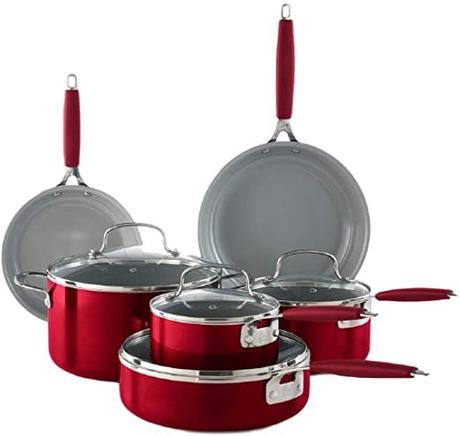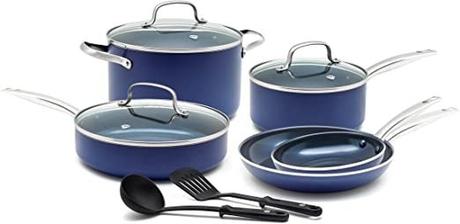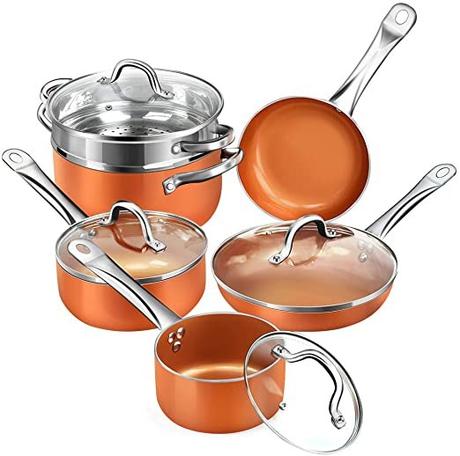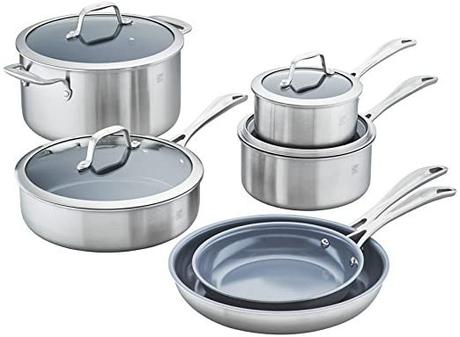When it comes to cookware, every experienced cook values practicality and effectiveness. As more knowledge about what materials are best for cooking equipment emerges, ceramic cookware has increased in popularity to a point where it is now commonly used in kitchens all over the world.
You might be interested in learning more about ceramic cookware, especially if you’re considering purchasing equipment for your kitchen. Whether you want to invest in some new pots and pans or compare new ceramic materials to the rest of your cookware, this guide is for you!
Ceramic Cookware
Demand for ceramic pots and pans has increased in recent years, and there are plenty of reasons why. It is usually toxin-free and a lot handier compared to older varieties of cookware, such as stainless steel. Many people have differing opinions on what a ceramic pot or pan is, so let’s look at that in the next few paragraphs.
Types of Ceramic Cookware

To put it simply, ceramic cookware usually refers to cookware that is baked in a kiln and specially glazed. However, pots and pans made of metals (such as aluminum) and coated with a ceramic covering also fall into this category. The differences between the two are minimal in terms of cooking but there is one practical difference that we mention a few sections down.
History of Ceramic Cookware
Historically speaking, ceramic pots and pans started to increase in popularity in the 1960s and 70s as a viable alternative to cookware made of stainless steel, which was slowly losing out on popularity because of its increased need for oils while cooking. Ceramic cookware, on the other hand, has gained prominence as a great nonstick cookware variety.
Ceramic Cookware Compared to Stainless Steel
We now know that ceramic pots and pans are safer than earlier types of cookware, such as stainless steel for the simple reason that they distribute heat across their surface a lot more evenly. Ceramic cookware can be prone to chipping and breaking though because it isn’t as durable and sturdy as stainless steel.
Pros and Cons of Ceramic Cookware
Here’s a simple, easy-to-follow look at the various pros and cons of using ceramic cookware. Hopefully, you’ll have a better idea of where ceramic pots and pans fit into your priorities once you go through these:
Pros:
- Usually nonstick
- Free from toxic fumes
- Easy to clean, with little to no scrubbing required
-
Generally affordable
- Require less oil to cook compared to other cookware
Cons:
- Short lifespan if ceramic coating wears off
- Relatively weak compared to stainless steel
- Prone to scratches from harder utensils, such as metal
-
Easily damaged by excessive heat
- Ceramic coating may be damaged in dishwashers with harsh detergents
Ceramic Pots

Ceramic pots have several useful advantages. We already know that pots are generally deeper than pans and their handles are positioned differently. Let’s look into this a bit more in the context of the unique advantages that ceramic pots can bring you.
- Firstly, ceramic cooking pots have a wide heating surface, which allows the even distribution of heat across the pot.
- Secondly, a ceramic pot with a wide heating surface makes it easier to cook slowly, for a long amount of time. This allows soft, even cooking where the liquid adds more flavor to the food.
- Thirdly, heated ceramic emits far-infrared energy, which is extremely useful while cooking. How so? Because it helps in cooking food thoroughly from the inside out naturally, without dehydrating it and without compromising the flavor and nutrients.
- Lastly, good ceramic pots have ceramic coatings that are made of natural materials and minerals. These natural coatings do not have harmful chemicals such as lead, which means that harmful chemicals won’t be leaching into your food while cooking.
Variations of Ceramic Pots
Ceramic pots come in all shapes and sizes. Let’s look at some of the unique, distinct features and options you can try when it comes to ceramic pots.
Some ceramic pots come with a multi-layer coating of granite and natural stone. These ceramic pots also usually have handles that stay cool during heating.
You can also find sturdier varieties that can withstand heat up to 500-800 degrees Fahrenheit.
If you’re tired of excess liquid in your food as you cook, you can find ceramic pots with a pour spout to get rid of the excess liquid.
Ceramic pots with tempered glass lids are also in demand these days! People like to keep an eye on their food as it cooks without having to lift the lid of the pot.
Is Ceramic Cookware Safe?

Now we’re getting to the slightly more difficult questions! But don’t worry, we’ve got your back.
As for whether ceramic cookware is safe or not, the simple answer is: yes. But then again, it’s not quite that simple.
A lot of ceramic cookware contains tin, which is one of the safest materials around. So it depends on the material your specific pot or pan is made of. Usually, ceramic cookware is mostly safe to use and you should not be worried about using it in your kitchen.
One of the biggest and most common concerns in this regard relates to people’s fear that a lot of leaching of harmful components and chemicals can occur when using ceramic cookware. Older ceramic cookware used to have very thin layers of coating, which would gradually chip off, leaving your food exposed to whatever metal the pot/pan was made from. But nowadays, a lot of manufacturers are using thicker coatings to counter this issue. Rest assured, your modern ceramic cookware is safe to use.
Another thing to keep in mind is that if your ceramic pots and pans, particularly older versions, have lead in them, you should avoid cooking acidic foods in those pots and pans. Acidic foods can increase the risk of lead leaching out from your ceramic cookware. Newer pots and pans do not have this issue though.
Overall, here’s one thing to remember: ceramic cookware is pretty safe. Even with minor chipping, the impact of any chemical is extremely minute. However, these effects can add up over some time, so not replacing your chipped pots and using them every day can eventually be harmful.
So what’s the takeaway? Take care of your ceramic cookware, throw it away if it chips, be sure to buy ceramic cookware made from a material that is low in toxicity, and buy cookware with thicker coatings to ensure your food doesn’t come into contact with the metal base.
Ceramic Cookware Sets
Due to the popularity that ceramic cookware enjoys, people tend to buy their cookware in sets instead of buying each pot or pan individually. In fact, people usually prefer buying all their kitchen utensils and gadgets in sets, it’s much more convenient and often saves a little bit of money.
There are no rules that determine what might be included in a set of ceramic cookware. Typically, it includes frying pans or roasting pans, also known as skillets, along with saucepans and casserole dishes. All these items come in more than one size in the same set, in addition to lids for all products. Usually, people pair up their ceramic cookware set with a set of spoons, ladles, spatulas, and other kitchen tools. For this reason, some ceramic cookware sets even include a set of spoons, even though these accessories aren’t necessarily ceramic products. This is a marketing tactic employed by traders, which – if you really think about it – benefits the purchasers too.
Although this marketing strategy benefits both the seller and the customer, some markets still sell ceramic pots and pans separately. So, if you aren’t looking to buy a stack of ceramic utensils together, you can look for markets that sell separate items. However, as you might’ve already concluded, this is less common.
Generally speaking, you might even find buying a whole set expensive when you only require a particular utensil, but if you look into it, it’s a one-time investment. While the cost may seem somewhat startling, it saves you time as you won’t have to go back every time you need a new item. Plus, you will end up saving some money when you purchase anything in sets, as the individual products are sold at a slightly higher price.
Nonetheless, if you’re not on a budget and price is not your first concern, feel free to buy separate ceramic utensils, because in the end it’s all about your own satisfaction.
Ceramic Skillet
Like every other pan or pot, a skillet – or frying pan – is also available in ceramic form. In fact, the use of ceramic frying pans is safer than using pans made of other materials, as long as it is exposed to a temperature no higher than 700 degrees Fahrenheit (this goes for all ceramic cookware).
As mentioned before, there’s one important thing you need to realize about ceramic cookware before making your purchase. It isn’t necessary that the ceramic skillet you’re buying is made only of pure ceramic materials. There are items available in the market that are only coated with ceramic materials on the outside but their cooking results are very similar. However, there are practical differences.
In order to figure out what to buy, you will need to narrow down reasons for preferring one item over the other. To make this easier for you, we’re here to help you out in the easiest possible way: a pure ceramic skillet should be the item on your list.
The reason behind this is the fact that even if a skillet made of 100% ceramic materials is more prone to breakage, it is safer because it involves no unwanted reactions during cooking. While ceramic coating produces similar cooking results, it doesn’t give you any advantage over the prior item because enamel layering is not as reliable, and therefore this might not be as safe as it seems. It’s even rather expensive.
If you’re looking to buy a safer utensil that will not contaminate your food in an unhealthy way, even during long cooking hours, while taking up minimum oil and letting your food glide easily, 100% ceramic cookware should be your number one preference.
100% Ceramic Cookware

As stated before, not all ceramic cookware items are made purely of 100% ceramic materials. Some of the items available in the market are just coated with ceramics. This is a very important piece of information for anyone who hasn’t already had the experience of using ceramic cookware. If you’re one of those people, don’t worry, we have you covered.
Utensils, pots, and pans that are referred to as 100% ceramic cookware are made completely of baked clay. The clay is baked at extremely high temperatures and is then shaped up to form pots and pans. As compared to the utensils that are only coated by ceramics, 100% ceramic cookware is the safer option. This is because the coating in the latter item is done through enamel layering and does carry a few health concerns with it if that layer breaks. To add to the cons, it’s also usually more expensive.
The safer alternative – 100% ceramic cookware – should be your first option since there are almost no health concerns in using this form of cookware. There are certainly no artificial chemicals in the utensil that could be unsafe for human health. Ceramic cookware contains no synthetics, and definitely doesn’t erode upon scrubbing.
If you’re still wondering whether 100% ceramic cookware is for you, we assure you there are little to no cons of the item for this type of ceramicware. It’s the best option for heat intensive cooking due to its ability to distribute heat evenly, with no concern for food contamination. It’s easy to clean because food doesn’t stick to it, and the surface doesn’t scrub off when using stain removers. Ultimately, it’s a toxin-free, environment-friendly choice for your cooking.
Ceramic vs. Nonstick
Now whether you’re familiar with ceramic cookware or not, nonstick cookware is an item commonly found in our houses. This was a revolutionary item introduced to our kitchens that enjoyed massive popularity for valid reasons.
As the name very much indicates, the top reason for its marketability was its ability to provide us with a surface that food wouldn’t easily stick to during cooking. This also means that cooking would take up a very small amount of oil for most foods, and even completely erase the need for oil in others. This was a very huge perk as it attracted all health-conscious individuals. It also managed to attract those obsessed with cleanliness, as nonstick cookware is very easy to clean and doesn’t require much scrubbing.
Ceramic cookware outwardly appears the same as nonstick cookware and because many people have been familiar with the former item for years, they tend to pick nonstick for their cooking options.
As good as it sounds, it’s not exactly the safer option. While ceramic cookware offers all the benefits and more that nonstick cookware offers, it carries no health concerns that are related to the use of nonstick cookware.
Nonstick cookware is layered with a special type of polymer, known as Teflon. Teflon is the reason we enjoy the benefits that come with nonstick pots and pans. However, it is harmful to human health and both the FDA and EPA have warned against the frequent use of nonstick cookware. Teflon can contaminate your food on high heat, and is also prone to delayering over time, especially with rough handling and cleaning. On the contrary, there are no known unsafe synthetics or dangerous chemicals present in ceramic cookware.
Now we know what you’re thinking: both the items have their own list of pros and cons and can be used for different cooking methods. But we assure you, ceramic cookware will have you covered for everything. Trust us on this one.
Copper Ceramic Cookware

Like the name very much implies in itself, copper ceramic cookware is a variety of coated ceramic cookware. In other words, copper ceramic pans and pots are layered with ceramic for a nonstick finish. Sometimes, however, aluminum cookware is coated with a layer of copper-toned ceramic and then referred to as copper ceramic cookware.
If you’re a person who is looking for the aesthetics that copper cookware gives your kitchen, this is exactly the item you have been looking for. Copper has its fair share of human health hazards, which in extreme cases even includes poisoning. But the introduction of ceramic coating has largely diminished these health concerns. The thick layer of ceramic coating prevents unsafe chemicals and toxins from spoiling your food, even at high temperatures. Even so, newer models of copper ceramic cookware are being introduced in the market and these utensils are considered 100% safe for cooking of any sort.
For a person who isn’t only in search of safe kitchen gadgets, but also wants to give a very trendy look to their kitchen, copper ceramic cookware might just be the item they have been looking for. It’s both safe and durable. However, if health safety is your primary concern, we would recommend you to prefer using pure ceramic cookware over copper ceramic cookware just in case the advertisements become outdated.
Ceramic Cookware Dangers
- The most important question that pops up in your mind when buying cookware is its lifespan. Unfortunately, ceramic cookware isn’t the best option out there if you’re looking for options with a long shelf life.
- The biggest danger to its lifespan comes from being more prone to breaking than metal options and it tends to become highly difficult to handle once its nonstick properties fail.
- This might happen for many reasons, including rough handling and cleaning, or using metal spoons, spatulas, or other utensils. This will result in a very scratched surface that will give it a rather ugly look due to visible lines and the color difference.
- Plus, if you’re using ceramic coated cookware instead of pure ceramic cookware, then it might also expose your food to dangerous chemicals present under the layer of ceramic after prolonged use.
- The reason we highly recommend pure ceramic cookware is because it prevents food contamination and thus benefits your health. However, a very important factor to take into consideration is that if you’re purchasing an overly cheap set of ceramic cookware, there is a high possibility that the utensils contain lead or other harmful materials.
- For health-conscious individuals, ceramic cookware is the best they can get in the market right now. But, it’s not as environmentally friendly as it seems. Yes, it contains no polymers or harmful chemicals but it is surely responsible for high amounts of energy consumption because of the heat that’s needed to produce it.
A Quick Recap
Still not sure which conclusion to draw? Don’t worry, we’re here to sum it up for you!
Like any other product in the market, we cannot overlook the cons of ceramic cookware, whether it’s about pure ceramic cookware or coated ceramic cookware. However, with all the instances provided above, it’s very easy to wind up the debate and conclude that ceramic cookware is the best you can get for your cooking and your health today. Adding up the concerns ceramic cookware brings with it, ceramic cookware is still the safest of all the options out there.
For these reasons, it’s already enjoying its fair share of popularity, although the competition from other products is still ongoing. Still, if you think ceramic cookware isn’t for you, whether it’s because of the short lifespan or any other reason that might be bothering you, you are free to choose from all the other varieties present, as long as they’re able to satisfy your needs.
